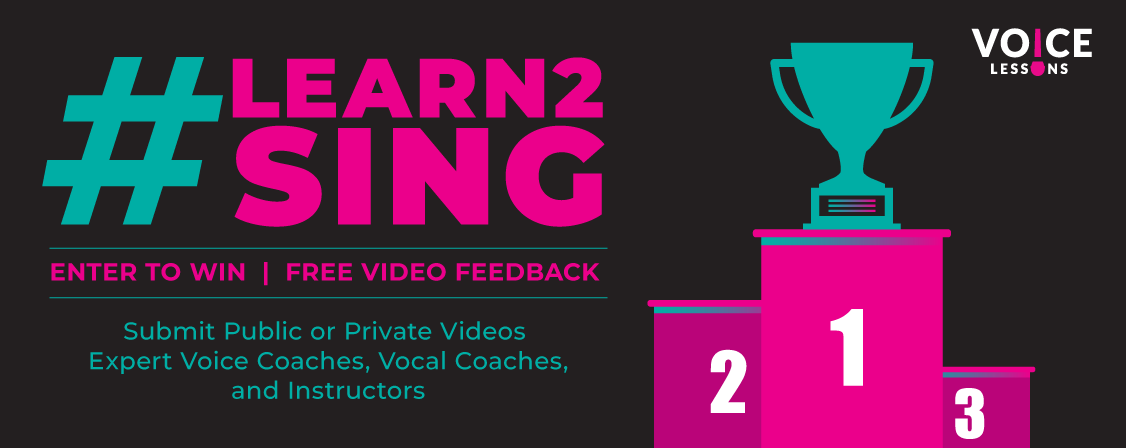
What is My Vocal Range – Identify, Master and Expand Your Range
Has this happened to you? You take a few voice lessons and you and your voice teacher begins to talk about learning some songs that you would enjoy singing. After all, not everyone gets satisfaction singing exercises forever. You bring in something exciting like Queen’s “Bohemian Rhapsody,” and your teacher convinces you to find something else… something easier.
Your teacher isn’t trying to dissuade you from ever learning the song. They might very well work with you on it at a later time. What your voice teacher is trying to do is help you find songs that fit into your vocal range. Some songs, like “Bohemian Rhapsody,” require hitting a wide range of notes. In other words, they require a wide vocal range.
Learning what vocal range is, where your normal range sits and how to expand it will get you closer to singing some of your favorite songs well.
What is My Vocal Range?
Vocal range is the tonal distance a person can sing. Songs are written and performed within a specific range and so if you can’t hit those notes or make the transitions, you might not succeed in performing the song well.
Tonal distance refers to the distance between the lowest and highest notes you can sing. So, when thinking about your vocal range, start by thinking about what warm-up exercises you are practicing, and how many notes are encompassed in them. Maybe you are warming up with the major and minor scales. Each scale is merely a group of pitches in ascending or descending order (with some alternatives that more experienced singers do).
For example, the C major scale starts at a C and ascends to a higher C, passing through all the notes in between: D, E, F, G, A and B. When you get to the higher C, you have sung a range of one octave, which is 8 notes.
You may sing this pattern in C major, D major, E major and F major without any problem, but once you get to G major you run into tension and a less beautiful tone. So you could then say you have a range from C to high F.
If your desired song has notes that are higher or lower than this range, it will be too difficult to work on without building up your skills and expanding your range. That’s why your teacher will decline to work on Bohemian Rhapsody right now!
The job of a teacher is to help you establish good technique in your current range and then to expand your range with exercises and insights that solve the problem you are having above high F. As with any physical skill in life, some people have more natural abilities than others. But everyone benefits from understanding their skills and building on them.
How Can I Identify My Voice Range?
Everyone has heard that a singer’s body is his instrument. Just like there is a difference in the type of sound that one violin can produce compared to another, there is a difference in the type of sound that each singer’s body can produce. You are probably already familiar with the major voice types, which are used to identify vocal range.
- Soprano: The range is B3 to G6 though most sopranos sing comfortably between B3 and C6. This is the female voice hitting the highest notes.
- Mezzo-Soprano: The range is officially from G3 to A5 with most typical mezzo-sopranos hitting this range and many hitting above and below it as well. Some sing as high as a soprano.
- Contralto (Alto): This is the lowest female voice type. The range is from E3 to F5.
- Countertenor: This is a rare male voice (who has trained to strengthen his head voice) who can sing high notes the same as a mezzo-soprano voice. Their range is G3 to C6.
- Tenor: This high male voice covers C3 to B4, with some singing higher and lower than this range.
- Baritone: The most common male voice type, the baritone has a typical range of G2 to G4. Baritones typically have a powerful voice with a lot of weight in the sound.
- Bass: Bass is the lowest male voice capable of singing the lowest notes possible for the human body. The range is D2 to E4.
While a singer might be classified as one voice type, many have the ability to sing notes above and below their typical type range. Voice subtypes describe singers who have expanded range beyond their typical major voice type. But it isn’t’ only about the range, as you’ll see below.
Your Voice Range is Created By Many Factors
Your voice type is identified based on a series of vocal variables. Only one of these variables is vocal range. Consider all the factors that go into classifying vocal range:
- Weight is the term we use to describe a characteristic in the voice described as light or heavy. Light voices are bright, sometimes metallic, and agile. Heavy voices are rich and powerful, sometimes darker in nature. Think about the difference between a flute and a trombone; the flute has a light sound while the trombone is heavy.
- Tessitura refers to the range that you sing most comfortably in. Songs you choose should have most notes in this range to not overly strain your voice and sound best.
- Timbre is the “color of the voice” which represents the unique qualities only your voice can create. Johnny Cash will always sound different than Tom Petty. Each has a unique sound that makes their songs distinctive and special.
- Physical stature is often an indicator of voice type, but it isn’t the end-all decider for voice type. While a larger man is usually seen as possessing a bass voice, it is possible that he is a baritone or tenor.
So how do you figure out your voice type?
Start here:
- Sing scales through the range you can accomplish easily.
- Determine which octaves you can go through quickly and efficiently
- Establish the top and bottom of your range
- Understand how other variables affect your voice
A vocal teacher is essential in helping you define your vocal range with your highest note and your lowest note abilities. You might not be able to hit all the notes in the range of your type, but that gives you the opportunity to start to strengthen your voice at those notes and then expand your range.
Should I Look to Expand or Master My Range?
Expanding your range is a personal choice. Professional singers work hard to maintain and expand vocal range but don’t always get bogged down trying to get more and more notes. Instead, they are working to master the range they already have.
It isn’t necessary to get caught up in building a wider range if you don’t plan on becoming an opera star like Cecilia Bartoli. Opera as a style of music places a high value on extending the range and singing those “impossible” notes beautifully. R&B styles do this as well. Not all music does not.
For some, mastering your natural vocal range is the goal because most songs you plan on singing are within that range. Mastering the range means learning to easily move through the octaves, navigate leaps and jumps, and maintain the desired vocal quality throughout an entire song or performance. Even though you might enjoy bragging rights with your friends because you can hit certain notes, it might be best if you don’t hit those notes very often. You’ll be less likely to injure your vocal chords, and you will learn to perform better in a faster period of time. So, if the songs you sing don’t require it, you might be better off by spending the time to master the range you have.
Performing is a lot more than hitting a high note. It requires progressing through a song that doesn’t always follow a simple octave progression. Become a singer, not just a note seeker.
Expanding Vocal Range
Once you have identified your existing vocal range and you need to expand it, you can begin that work. Don’t expect this to yield immediate and broad results. Even professional opera singers have limits to their range. While you might not be able to expand to the widest of ranges, you should be able to find new notes to hit on a regular basis. Be patient.
-
- Regularly exercise your voice using a planned, skill-building routine of vocal warm ups.
- Get comfortable with what you know you can do without strain.
- Practice exercises like scales, thirds and fourths, and run your voice through your personal vocal range systematically.
- Regularly exercise your voice using a planned, skill-building routine of vocal warm ups.
-
-
- When ready, try a note higher than your normal top octave range.
- This is the same as a weight lifter adding half a pound to a bench press. Once you are at the limits, every little bit makes a difference.
- Try to hold the note and go back down to the octaves you know you can hit.
- Continue through your octaves trying the new note every four or five progressions.
- You may even try to hum the note to get a handle on higher-pitched notes.
- Maintain good posture and breath support while working through octave progressions.
- Over time, you should be able to hit the higher note more consistently.
- When ready, try a note higher than your normal top octave range.
-
And, yes, you can do this on your own. But, you increase your chance of faster and more lasting success when you have a good voice teacher. A teacher will not only be able to recognize when you are ready to hit a higher note, they will also be able to identify the weaknesses in your voice when trying to expand. He can help you work through those limitations to successfully expand your singing range.
What Causes Alterations in Voice Over Time?
Your voice can and probably will change over time. It probably already had a significant voice change during puberty as hormones and physical growth changed the design of your instrument. Injury and aging can also alter sound and tone of your voice.
As we age, men’s voices become higher pitched while women’s voices become lower pitched. Projection weakens; this is also called a “thin voice.” As with every physical activity, endurance weakens over time making it more difficult to hold the voice, thus, resulting in a shaky voice.
But all that is minimized if you maintain good physical conditioning and strong practice skills when singing. Most people can prevent significant problems with the right training. Vocal fitness programs exist and your vocal teacher or an occupational speech therapist can help you develop a vocal fitness plan.
Beware: You Can Hurt Your Voice Permanently
Once you get an idea of how to train and improve your range, it gets exciting. You may find yourself wanting to practice more often and push limits further. However, don’t be lured into the trap of overdoing it.
It’s a trap because you rarely realize you are overdoing it while you are overdoing it. If you start to feel any scratchiness or hoarseness in your throat, even though you’re having a ball, it’s time to take a break and reduce practice time. If you don’t stop, you might hurt your voice permanently.
Who doesn’t love The Sound of Music? Julie Andrews’ voice resonated across Austrian mountains, making all of us want to get up and twirl in gleeful song and dance. In 1997, Andrews needed to have surgery to remove non-cancerous nodules from her vocal cords. These nodules were the result of years and years of hitting high notes for extended periods of time. For many people, nodule surgery is successful and allows them to get back to normal singing practice. However, this soprano superstar never recovered her singing voice from the surgery. Malpractice or not, the world lost Julie Andrews as a vocal powerhouse.
Sure, not everyone is singing for 60 plus years on a professional platform, hitting the high notes on a daily basis. But, the lesson remains the same: No one is exempt from potential injury. This is no different for athletes or for singers.
General Health Considerations
Work to improve your voice and your vocal range; but, as you do, pay particular attention to your voice health. Smoking and drinking are a surefire way to increase your chances of developing nodules, raspiness and hoarseness. There are many tips and tricks that professional singers use to keep their voice healthy such as:
-
- Stay hydrated: Drink lots of water to keep everything loose and limber
- Use steam to soothe an achy throat: Steam reduces the swelling and eases the pain
- Consider drinking tea with honey: Honey has soothing and antibacterial qualities
- Develop the habit of using good breath support: Do this daily when you sing and when you speak
- Don’t drink alcoholic beverages or smoke: Among other serious issues like developing cancer, these can cause such things as plaque to form on vocal cords. It can also be drying which triggers hoarseness
- Know when to take a break: While, perhaps, the most difficult for an eager student, think of it this way, it is better not practice for a week than it is not sing for months
- If pain or hoarseness persist, check with your doctor. You may need to see a specialist for head and neck issues called an otolaryngologist. Ruling out more serious conditions like cancer is important. Work with your doctor and your vocal teacher to develop a vocal health plan that keeps you singing in a healthy fashion. What Does Mastery Look Like?
Think about anything you have done in your life and mastered. It took time and probably a lot of errors before you mastered it. Take writing, for example. A child learning to write is quite slow, may be somewhat sloppy and, at times, may transpose the way letters are made. Most children learn expanded writing skills like cursive. However, few will learn to write in calligraphy, and even fewer will master it.
How does this relate to singing range? When you begin singing, you are like the child just learning to print letters and numbers. You have to trace them to start, meaning you probably have to practice simple exercises with a piano or other instrument accompaniment. When you master this you will learn to expand your abilities. Like the child learning cursive, you will learn to sing without accompaniment and perhaps expand your range a note or two.
Those who want more will continue to work to master skills, making transitions cleaner and improving the duration of note length. Over time, a few will decide to expand further, like someone ready to learn a finer art of calligraphy.
You don’t need to work for years and years – you just need to work enough to get to a place where you will feel good about your voice. You need to have a handle on your vocal range and your voice control.
A vocal teacher can help you establish goals that meet your ability and desire. Focus on the basics before you spend a lot of time expanding your range. This reduces the chance of injury and improves your ability to work with your voice type more naturally.
Is Range What You Really Need?
While expanding your range may seem like a top priority when you start, you might realize that you have a wider range than originally thought. Many singers in choirs are put in with the altos not because they are truly within this range but because they are singing off-tune.
When someone isn’t hitting notes properly, singing with a group of altos allows them to blend in easier; whereas, mistakes stick out a bit more among other mezzo-sopranos and sopranos. Work with a voice teacher to truly identify your range and voice type.
Once you do this, spend time to strengthen your existing abilities. With just 15 to 20 minutes of daily exercise routine, you can develop a strong foundation for your vocal range. If you want to expand from there, great! Then, follow the steps to patiently work higher or lower notes into your range. Keep in mind that it will probably be easier to hit lower notes than higher notes; but that isn’t a guarantee, depending on your natural voice type and timbre.
Then, when you have your skills more organized you will be able to consider singing in the soprano section or learning songs with more difficulty and bigger range.
If you are looking for help in identifying your voice type and expanding your vocal range, contact us for a consultation. Getting a professional on your side will help you become the strong singer you desire to be.
about the author
Mike Elson Mike loves to sing and make magic happen with computers and music. After trying lots of ways that didn't work to find... Read More

RECENT ARTICLES
RECENT IN KNOWLEDGE
Recent Topics
- Beginning Voice Lessons (1)
- Breathing Techniques (1)
- Confidence (1)
- Experienced Teacher (1)
- Kids Singing Lessons (1)
- Musical Career (1)
- Practice (1)
- Private Lessons (1)
- Professional Singer (2)
- Sing (1)
- Singing Teachers (2)
- Style (1)
- Teach Online (1)
- Vocal Exercises (1)
- Vocal Health (1)
- Vocal Music (1)
- Vocal Pitch (3)
- Vocal Range (4)
- Voice Coach (1)
- Voice Exercises (2)
- Voice Training (4)
- Young Vocalist (1)
Categories
- Basic Skills (7)
- Beginners (8)
- Career (2)
- CCM (1)
- Contemporary Commercial Music (1)
- Crossing Over (1)
- Exercises (2)
- Online Lessons (3)
- Online Voice Lessons (1)
- Songs (2)
- Students (6)
- Tips (4)
- Vocal Coaches (1)
- Voice Teachers (2)
- Warmups (2)
Testimonials




















